
Santiago de Compostela or Compostela is the capital of the autonomous community of Galicia, in northwestern Spain. The city has its origin in the shrine of Saint James the Great, now the Cathedral of Santiago de Compostela, as the destination of the Way of St. James, a leading Catholic pilgrimage route since the 9th century. In 1985, the city's Old Town was designated a UNESCO World Heritage Site.

Alfonso Daniel Manuel Rodríguez Castelao, commonly known as Castelao, was a Galician politician, writer, painter and doctor. He is one of the fathers of Galician nationalism, promoting Galician identity and culture, and was one of the main names behind the cultural movement Xeración Nós. He was also one of the founders and president of the Galicianist Party and had a great influence on the renovating group of Galician art known as Os renovadores. Castelao is considered to be the most important figure in Galician culture of the 20th century.
The Xunta de Galicia is the collective decision-making body of the government of the autonomous community of Galicia, composed of the President, the Vice-President(s) and the specialized ministers (Conselleiros).

The Santiago de Compostela Arch cathedral Basilica is part of the Metropolitan Archdiocese of Santiago de Compostela and is an integral component of the Santiago de Compostela World Heritage Site in Galicia, Spain. The cathedral is the reputed burial place of Saint James the Great, one of the apostles of Jesus Christ. It is also among the remaining churches in the world built over the tomb of an apostle, the other ones being St Peter's Basilica in Vatican City, St Thomas Cathedral Basilica in Chennai, India and Basilica of St. John in Izmir, Turkey.
The Compostela Group of Universities (CGU) is an international non-profit association that promotes and executes collaboration projects between institutions of higher education. It currently has 67 full members, 2 associate members and 9 mutual membership agreements with institutions from 27 different countries.

The University of Santiago de Compostela - USC is a public university located in the city of Santiago de Compostela, Galicia, Spain. A second campus is located in Lugo, Galicia. It is one of the world's oldest universities in continuous operation.
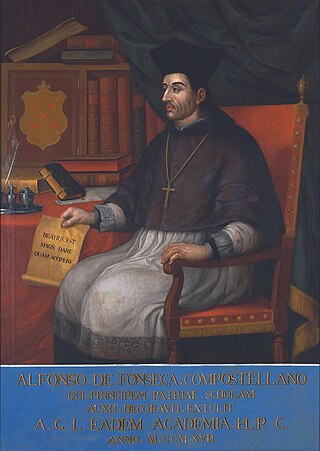
Alonso III Fonseca was a Galician archbishop and politician. He was archbishop of Santiago de Compostela from 1507, and archbishop of Toledo from 1523. He was a major supporter of the University of Santiago de Compostela. He was the son of the archbishop Alonso II Fonseca and Alonso II's concubine María de Ulloa.
Monasteries in Spain have a rich artistic and cultural tradition, and serve as testament to Spain's religious history and political-military history, from the Visigothic Period to the Middle Ages. The monasteries played an important role in the recruitment conducted by Christian aristocracy during and after the progress of the Reconquista, with the consequent decline in the Muslim south of the peninsula.
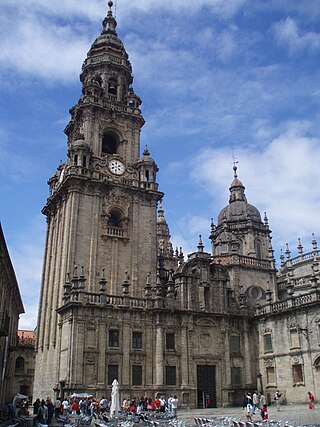
Domingo Antonio de Andrade was a Galician baroque architect, a leading figure in the emergence of Galician Baroque architecture.

The ruins of San Domingos was a convent located in Pontevedra, Galicia (Spain). It was declared Bien de Interés Cultural in 1895.

Sindicato Labrego Galego-Comisións Labregas is a Galician farmers' and breeders' union centered on family farms and small peasants.
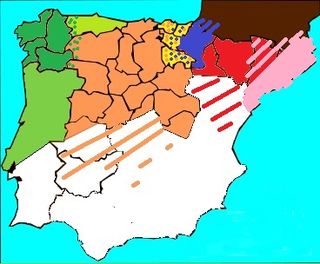
Spanish Romanesque designates the Romanesque art developed in the Hispanic-Christian kingdoms of the Iberian Peninsula in the 11th and 12th centuries. Its stylistic features are essentially common to the European Romanesque although it developed particular characteristics in the different regions of the peninsula. There is no Romanesque art in the southern half of the peninsula because it remained under Muslim rule (Al-Andalus). The examples of Romanesque buildings in the central area of the peninsula are sparse and of the latest period, with virtually no presence south of the Ebro and the Tagus. Most Romanesque buildings can be found in the northern third of the peninsula. Romanesque art was introduced into the peninsula from east to west, so scholars have usually defined regional characteristics accordingly: the "eastern kingdoms" comprising the Pyrenean areas, Catalan Romanesque, Aragonese Romanesque and Navarrese Romanesque, and the "western kingdoms" comprising Castilian-Leonese Romanesque, Asturian Romanesque, Galician Romanesque and Portuguese Romanesque.
Bernal(do) de Bonaval(le), also known as Bernardo (de) Bonaval, was a 13th-century troubadour in the Kingdom of Galicia who wrote in the Galician-Portuguese language.

Antonio Fraguas Fraguas was Galicianist historian, ethnographer, anthropologist, and geographer. In 1923, he cofounded the Sociedade da Lingua, whose main goals were the defense of the Galician language and the creation of a dictionary. He was a member of Irmandades da Fala and Seminario de Estudos Galegos and was high school professor after the Spanish Civil War broke out. He was part of the Father Sarmiento Institute for Galician Studies and the Royal Galician Academy, and was director and president of the Museum of the Galician People, member of the Council of Galician Culture, and a chronicler of Galicia. He spent his life studying Galician culture and its territory from different perspectives, with a special focus and mastery on anthropology.

The Pontevedra Museum is a museum in the Galician city of Pontevedra in Spain. It was founded by the Provincial Deputation of Pontevedra on 30 December 1927 and has six buildings for its exhibitions. It has permanent and temporary exhibition rooms. The museum's collections are multidisciplinary, classified into rooms for painting, sculpture, archaeology, decorative arts, engraving and ethnography.
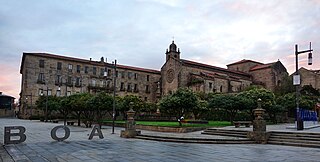
The Convent of St. Francis is a Franciscan convent located in the city centre of Pontevedra (Spain), overlooking the Plaza de la Herrería. The Gothic church of San Francis is attached to the convent on the southeast side.
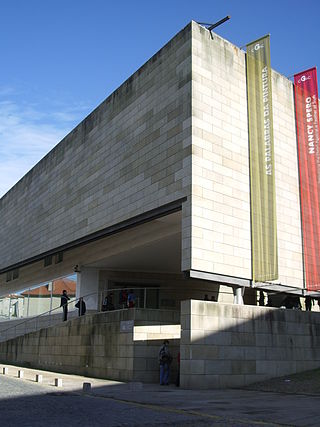
The Centro Galego de Arte Contemporánea, CGAC is an arts centre based in Santiago de Compostela that aims to promote culture in Galicia through exhibition, enjoyment and knowledge of the trends and currents of contemporary artistic creation.

Os Renovadores or Os Novos was a group of artists who wanted to renew the visual Galician arts from the 1920s.

Quintana Square is the main square of Santiago de Compostela, Galicia, Spain. It is formed by the meeting of the south facade of Santiago de Compostela Cathedral, Casa da Parra, Monastery of Saint Pelagius of Antealtares and Casa da Conga.

















